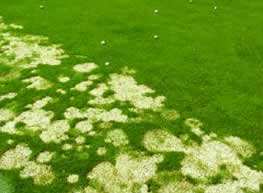Gray Snow Mold
 Description: Gray snow mold affects all cool season turfgrass species in areas where there are extended periods of snow cover. The diseaseis caused by either of two Typhula species: infections may progress down into the crown, resulting in plant death or more severe and lasting damage. Description: Gray snow mold affects all cool season turfgrass species in areas where there are extended periods of snow cover. The diseaseis caused by either of two Typhula species: infections may progress down into the crown, resulting in plant death or more severe and lasting damage.
Damage: T. incarnate outbreaks are normally less severe, and infected patches tend to recover more quickly in the spring. In areas without prolonged snow cover, gray snow mold damage to turf is largely cosmetic. Gray snow mold requires snow cover for infection and patch development. Some pathogen activity occurs in the fall during periods of cool, wet weather. The extent of actual infection in fall is not clear.
Since turf damage associated with infection and disease progress is favored by cold (32°F to 36°F), wet conditions, extended periods of snow cover provide ideal conditions for snow mold to establishment and spread. On taller mown turf, matted grass blades may provide a similar insulate environment, but outbreaks normally are not severe without prolonged snow cover.
 Control: Continued mowing of lawns, landscapes, sports fields, and golf course roughs to a height of 2 1/2 inches into the dormant period will decrease the risk that matted turf will provide favorable conditions for disease development. Snow management (such as strategically removing snow and using snow fences) will limit the opportunities for extended periods of Control: Continued mowing of lawns, landscapes, sports fields, and golf course roughs to a height of 2 1/2 inches into the dormant period will decrease the risk that matted turf will provide favorable conditions for disease development. Snow management (such as strategically removing snow and using snow fences) will limit the opportunities for extended periods of  snow cover in locations where quality turf is a high priority. Turf areas damaged and thinned by gray snow mold can be repaired by raking and over seeding as soon as possible in the spring. Also, in almost all cases, affected turf will recover in spring with moderate maintenance. Recovery of turf from affected patches may be hastened by raking the matted turf grass, which facilitates air movement within the turf canopy. snow cover in locations where quality turf is a high priority. Turf areas damaged and thinned by gray snow mold can be repaired by raking and over seeding as soon as possible in the spring. Also, in almost all cases, affected turf will recover in spring with moderate maintenance. Recovery of turf from affected patches may be hastened by raking the matted turf grass, which facilitates air movement within the turf canopy.
|

